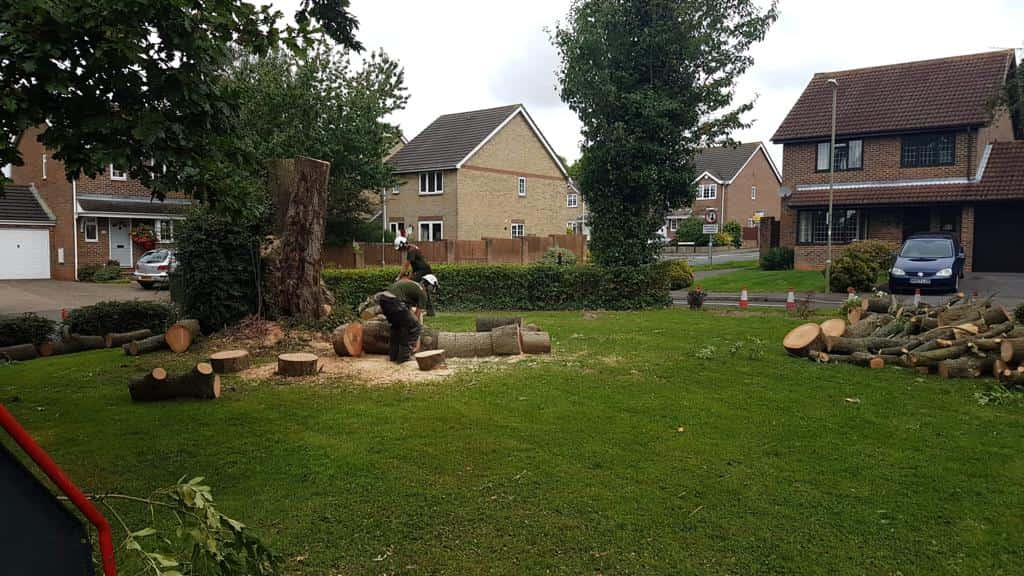The Silent Danger of a Dying Tree
Trees add beauty, shade, and value to a property, but when they start to decline, they can pose serious risks. A dying tree may seem harmless at first, but over time, its weakened structure can become a major hazard. Ignoring the warning signs can lead to property damage, safety hazards, and costly emergency removals.
For homeowners and landowners in Brockworth, Gloucestershire, understanding the risks of leaving a dying tree untreated is crucial. Early intervention not only protects your property but also ensures the safety of people and surrounding structures.
Signs of a Dying Tree
Before delving into the dangers, it’s important to recognise the signs of a dying tree:
- Brittle or falling branches – Frequent branch drop, even in calm weather, can indicate decay.
- Fungal growth – Mushrooms or fungi at the base of a tree suggest internal rot.
- Cracks or splits in the trunk – Deep fractures weaken the tree’s stability.
- Sparse or discoloured leaves – An uneven canopy or dead patches may indicate disease.
- Leaning or unstable structure – A tree that tilts suddenly could be close to collapsing.
Ignoring these warning signs can lead to significant consequences.
The Risks of Ignoring a Dying Tree
1. Increased Risk of Falling Branches
As trees weaken, their branches become brittle and unstable. Even a light breeze or rainfall can cause large limbs to snap and fall, posing a danger to:
- Pedestrians walking beneath the tree
- Vehicles parked nearby
- Power lines, fences, and structures on the property
Falling branches can cause expensive damage and, in some cases, serious injury.
2. Complete Tree Failure and Collapse
A dying tree left untreated will eventually reach the point where it can no longer support its own weight. A full tree collapse can lead to:
- Severe structural damage to homes, garages, and outbuildings
- Road obstructions that require urgent clearance
- Legal liability if it damages a neighbouring property or injures someone
Storms and heavy winds significantly increase the risk of sudden tree failure.
3. Spread of Disease to Healthy Trees
If a tree is dying due to disease, leaving it untreated can result in the infection spreading to nearby trees. Common tree diseases such as Dutch elm disease, ash dieback, and honey fungus can decimate large sections of woodland and landscaped areas if not controlled.
- Fungal infections spread through the soil and root systems.
- Airborne diseases can infect nearby trees, leading to widespread decline.
- Removing an infected tree early helps to protect the surrounding environment.
4. Pest Infestations
Dying trees attract pests such as beetles, termites, and wood-boring insects. Once an infestation takes hold, these pests can:
- Spread to healthy trees, causing further damage.
- Make their way into nearby buildings, creating additional problems.
- Weaken the structural integrity of the tree, accelerating decay.
Prompt removal of a dying tree can help prevent an outbreak of pests on your property.
5. Decreased Property Value and Curb Appeal
A neglected, dying tree can significantly impact the appearance and value of a property. Potential buyers may see it as an immediate problem, leading to:
- Reduced property value due to visible tree damage.
- Increased concerns about safety risks and maintenance costs.
- A negative impact on overall landscape aesthetics.
Regular tree care and timely removal of problem trees help maintain a property’s appeal and marketability.
When to Take Action
If a tree is showing signs of decline, it’s important to act quickly. Contacting a professional tree surgeon ensures a proper assessment and the best course of action. Depending on the tree’s condition, options may include:
- Tree pruning – Removing dead or weak branches to prolong the tree’s lifespan.
- Tree felling – Safely removing a dying tree before it becomes a hazard.
- Stump grinding – Ensuring the complete removal of a tree’s base to prevent regrowth or fungal spread.
Conclusion
Ignoring a dying tree can lead to costly, dangerous consequences. From falling branches to property damage and pest infestations, the risks of inaction far outweigh the benefits of early intervention. Addressing the problem sooner rather than later helps to ensure safety, protect surrounding trees, and maintain the visual appeal of your property.
For property owners in Brockworth, Gloucestershire, professional tree care is essential in managing tree health and preventing potential hazards. If you suspect a tree is dying, consulting a qualified tree surgeon will provide expert guidance on the best course of action.
Call us on: 01452 941 558
Click here to find out more about EM Tree Surgery Brockworth
Click here to complete our contact form and see how we can help with your tree needs.

